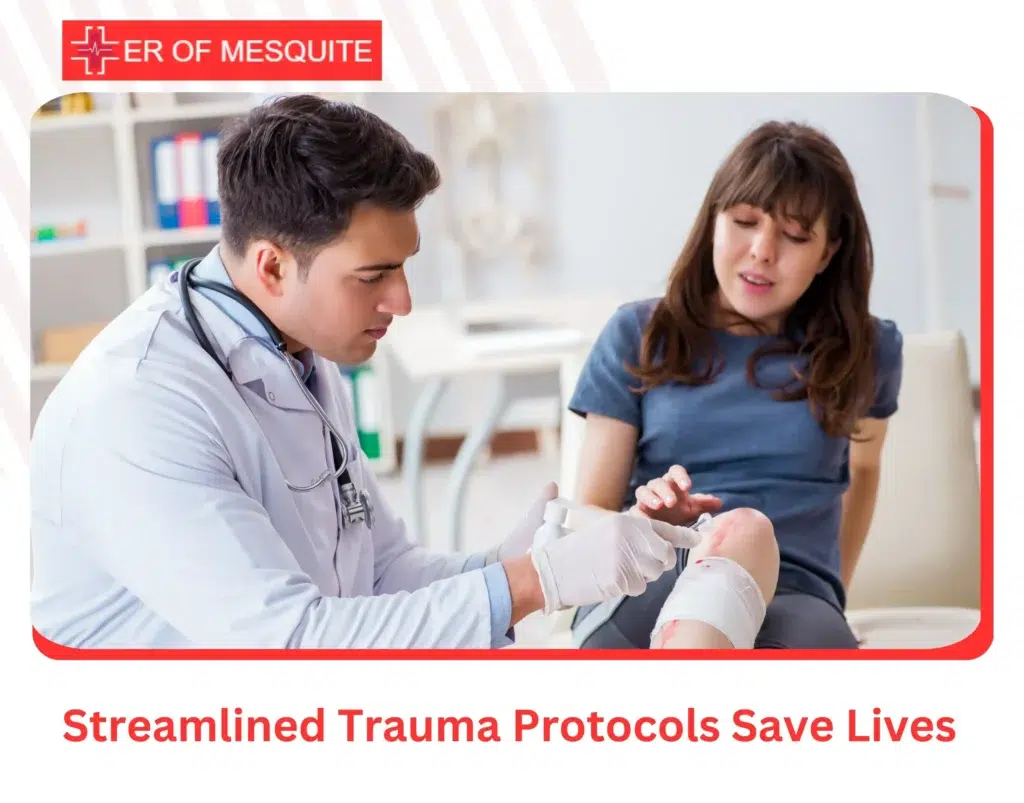When someone is seriously hurt, every second matters. Whether it’s a car crash, a fall, or another sudden injury, what happens next can mean the difference between complete recovery and long-term complications.
Emergency physicians now apply techniques unimaginable a decade ago, from advanced imaging that reveals hidden injuries to protocols that coordinate complex treatment in seconds rather than hours.
Before exploring these life-saving innovations, let’s first understand what trauma care actually involves.
Understanding Trauma Care
Trauma care refers to the specialized medical response to severe injuries that can result from accidents, falls, violence, or natural disasters. These injuries often involve multiple organ systems and require immediate, coordinated intervention. Modern trauma care typically involves a multidisciplinary team of professionals including trauma surgeons, emergency physicians, anesthesiologists, nurses, and rehabilitation specialists.
At its core, effective trauma care in the ER depends on:
- Rapid assessment and triage
- Stabilization of airway, breathing, and circulation (the ABCs)
- Advanced diagnostic imaging
- Pain management and wound care
- Rehabilitative care
The integration of emergency protocols has revolutionized advanced trauma care. Proper initial stabilization during those critical first minutes dramatically improves survival rates, even before reaching definitive care settings.
How Modern Trauma Treatment Has Transformed
Traditional trauma care focused on stabilizing physical injuries and controlling bleeding. While these remain crucial, today’s approach is much more holistic. It includes:
- Immediate assessment and triage
- Rapid diagnostics with advanced imaging
- Evidence-based trauma protocols
- Early surgical and pharmacological intervention
- Post-resuscitation monitoring and care
- Better coordination between emergency facilities
Emergency physicians now employ sophisticated protocols that rapidly identify life-threatening conditions, provide immediate stabilization, and when necessary, coordinate seamless transfers to specialized trauma centers for advanced treatment.
Immediate Assessment: Trauma Care Without the Wait
Unlike crowded hospital emergency departments, our approach to trauma care eliminates extended waiting periods. Patients receive immediate attention from board-certified emergency physicians, bypassing the typical triage delays that can compromise outcomes in critical situations.
When someone suffers a traumatic injury, our team springs into action right away to perform rapid assessments and initiate stabilization measures. This immediate response helps prevent complications and improves recovery prospects during those vital first moments.
Advanced Imaging for Faster Diagnosis
Swift and accurate diagnosis is central to effective trauma care. Our diagnostic capabilities include:
- CT scans with or without contrast
- Digital X-rays for bone fractures and spinal assessments
- Ultrasound imaging for internal assessment
- Combined X-ray imaging for complex trauma
- Dental and abdominal radiographs
These tools allow our emergency team to detect injuries that are not immediately visible. For instance, internal hemorrhages and organ damage often require high-resolution imaging for proper identification. Our radiology team is trained to interpret these images rapidly for prompt action.
Laboratory Support at the Point of Care
Modern trauma care involves real-time decision-making. At ER of Mesquite, we provide fast-turnaround lab testing to support critical diagnoses. Some essential lab tests include:
- Cardiac enzyme tests: To evaluate heart strain or damage, particularly in chest trauma
- Blood type and crossmatch: For urgent transfusions
- Complete blood count (CBC): To check for anemia or infection
Our on-site clinical laboratory ensures that results are available in minutes, not hours, so life-saving treatments can be started without delay.
Streamlined Trauma Protocols Save Lives
Our emergency medicine professionals follow evidence-based trauma protocols that eliminate guesswork and maximize efficiency during critical moments. This systematic approach includes:
- Immediate airway, breathing, and circulation assessment
- Thorough physical examination for hidden injuries
- Continuous vital sign monitoring
- Clear communication between all care team members
These structured protocols ensure nothing gets overlooked during those vital first minutes. By standardizing emergency response, we deliver consistent, high-quality care that stabilizes patients quickly, which is often the most crucial factor in trauma outcomes.
Intravenous (IV) Therapy for Stabilization
IV therapy forms the cornerstone of initial trauma stabilization. Our emergency teams rapidly establish IV access to:
- Replace lost fluids and prevent shock
- Administer pain medication for comfort
- Deliver medications that prevent complications
- Correct electrolyte imbalances
For trauma patients experiencing significant fluid loss, immediate IV access can dramatically improve outcomes. Our 24/7 emergency physicians are skilled at establishing IV lines even in challenging trauma situations to ensure that patients receive essential medications and fluids without delay.
Pediatric Trauma: A Special Focus
Trauma care for children is not simply adult care scaled down. Kids require different assessments, equipment, and treatment approaches. Our emergency physicians understand these crucial differences, including:
- Age-specific vital sign parameters
- Weight-based medication dosing
- Tailored pain management techniques
- Child-appropriate communication strategies
We prioritize both rapid medical assessment and emotional support for young patients and their families. Our team establishes a calm environment while efficiently handling injuries like fractures, burns, and concussions.
What Today’s Trauma Care Means for You
Modern emergency medicine has revolutionized trauma outcomes through immediate assessment, advanced diagnostics, and evidence-based protocols. The integration of these elements creates an effective system that begins working from the moment a patient arrives.
At the ER of Mesquite, our emergency physicians employ on-site imaging and advanced lab services to evaluate and treat traumatic injuries. With 24/7 availability and no appointment necessary, you’ll receive prompt trauma care regardless of when the injuries occur.
FAQs
1. What are the latest advancements in trauma care?
Modern trauma care now features point-of-care ultrasound, specialized bleeding control techniques, rapid diagnostic imaging, and damage control resuscitation. All these elements reduce treatment time and improve survival rates.
2. How do trauma protocols improve patient survival rates?
Trauma protocols eliminate guesswork so critical steps happen in the right sequence. This systematic approach prevents missed injuries and reduces treatment delays, which directly improves survival outcomes.
3. How does prehospital trauma care impact survival rates?
Early interventions like bleeding control and airway management during the “golden hour” significantly improve outcomes. Quick transport decisions and pre-arrival notification help emergency teams prepare for immediate treatment.
4. How do trauma centers differ from regular hospitals?
Dedicated trauma centers follow specialized trauma protocols, offering advanced surgical interventions, intensive care, and rehabilitation services tailored for severe injuries.
5. What are the 4 R’s of trauma care?
The 4 R’s of trauma-informed care ensure compassionate patient treatment: Realization acknowledges trauma’s impact, Recognition identifies symptoms, Response applies trauma protocols, and Resist Re-traumatization prevents further distress during medical care.



